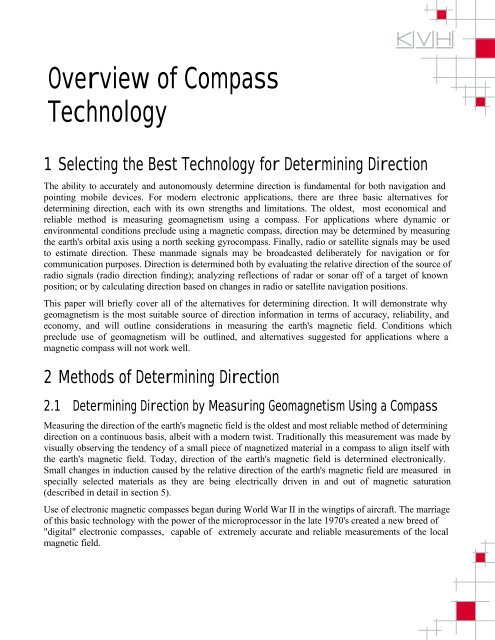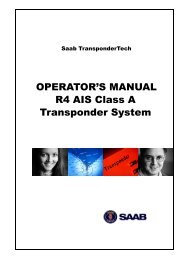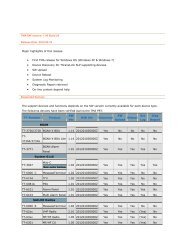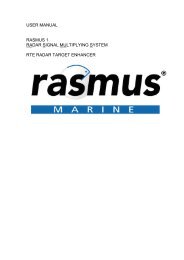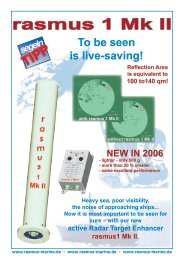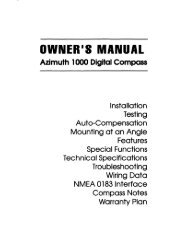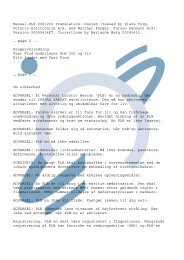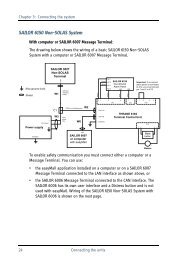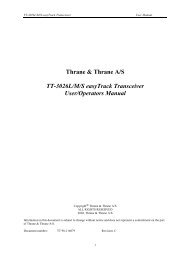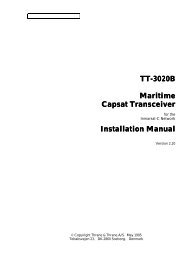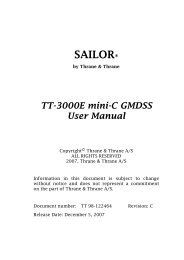Overview of Compass Technology - KVH Industries, Inc
Overview of Compass Technology - KVH Industries, Inc
Overview of Compass Technology - KVH Industries, Inc
Create successful ePaper yourself
Turn your PDF publications into a flip-book with our unique Google optimized e-Paper software.
<strong>Overview</strong> <strong>of</strong> <strong>Compass</strong><br />
<strong>Technology</strong><br />
1 Selecting the Best <strong>Technology</strong> for Determining Direction<br />
The ability to accurately and autonomously determine direction is fundamental for both navigation and<br />
pointing mobile devices. For modern electronic applications, there are three basic alternatives for<br />
determining direction, each with its own strengths and limitations. The oldest, most economical and<br />
reliable method is measuring geomagnetism using a compass. For applications where dynamic or<br />
environmental conditions preclude using a magnetic compass, direction may be determined by measuring<br />
the earth's orbital axis using a north seeking gyrocompass. Finally, radio or satellite signals may be used<br />
to estimate direction. These manmade signals may be broadcasted deliberately for navigation or for<br />
communication purposes. Direction is determined both by evaluating the relative direction <strong>of</strong> the source <strong>of</strong><br />
radio signals (radio direction finding); analyzing reflections <strong>of</strong> radar or sonar <strong>of</strong>f <strong>of</strong> a target <strong>of</strong> known<br />
position; or by calculating direction based on changes in radio or satellite navigation positions.<br />
This paper will briefly cover all <strong>of</strong> the alternatives for determining direction. It will demonstrate why<br />
geomagnetism is the most suitable source <strong>of</strong> direction information in terms <strong>of</strong> accuracy, reliability, and<br />
economy, and will outline considerations in measuring the earth's magnetic field. Conditions which<br />
preclude use <strong>of</strong> geomagnetism will be outlined, and alternatives suggested for applications where a<br />
magnetic compass will not work well.<br />
2 Methods <strong>of</strong> Determining Direction<br />
2.1 Determining Direction by Measuring Geomagnetism Using a <strong>Compass</strong><br />
Measuring the direction <strong>of</strong> the earth's magnetic field is the oldest and most reliable method <strong>of</strong> determining<br />
direction on a continuous basis, albeit with a modern twist. Traditionally this measurement was made by<br />
visually observing the tendency <strong>of</strong> a small piece <strong>of</strong> magnetized material in a compass to align itself with<br />
the earth's magnetic field. Today, direction <strong>of</strong> the earth's magnetic field is determined electronically.<br />
Small changes in induction caused by the relative direction <strong>of</strong> the earth's magnetic field are measured in<br />
specially selected materials as they are being electrically driven in and out <strong>of</strong> magnetic saturation<br />
(described in detail in section 5).<br />
Use <strong>of</strong> electronic magnetic compasses began during World War II in the wingtips <strong>of</strong> aircraft. The marriage<br />
<strong>of</strong> this basic technology with the power <strong>of</strong> the microprocessor in the late 1970's created a new breed <strong>of</strong><br />
"digital" electronic compasses, capable <strong>of</strong> extremely accurate and reliable measurements <strong>of</strong> the local<br />
magnetic field.
2.1.1 Advantages <strong>of</strong> Measuring the Earth's Magnetic Field<br />
No other physical property is so readily available and easily measurable on a consistent basis as the<br />
earth's magnetic field. Using it to determine direction does not require visual confirmations <strong>of</strong> known<br />
landmarks or any external source <strong>of</strong> manmade information. Advances in modern electronics have all but<br />
overcome historic limitations in compass design, making the modern electronic compass the most<br />
accurate, reliable, and economical tool for determining direction in most applications.<br />
2.1.2 Limitations <strong>of</strong> Measuring the Earth's Magnetic Field<br />
The earth's magnetic field provides such a reliable source <strong>of</strong> accurate information, decisions to use<br />
something other than a compass to determine direction are usually made only in four very specific<br />
situations:<br />
1. The host platform's magnetic field (deviation) is so strong it prevents accurate measurement <strong>of</strong> the<br />
earth's field.<br />
2. The earth's field is too inconsistent to provide accurate information due to natural or manmade<br />
magnetic anomalies which distort the local magnetic field in an unpredictable way.<br />
3. The vertical component <strong>of</strong> the earth's field is much stronger than the horizontal component (dip<br />
angle).<br />
4. The dynamic conditions (accelerations) <strong>of</strong> the application prevent consistent measurement <strong>of</strong> the<br />
earth's horizontal magnetic field with the available compass technology.<br />
These problems must be carefully considered when selecting a direction finding technology for a<br />
particular application, so they will be thoroughly reviewed in sections 3 and 4. Fortunately, as described<br />
in section 5, modern electronic technology is able to provide solutions which overcome all but the most<br />
serious <strong>of</strong> these limitations.<br />
2.2 Determining Direction by Maintaining a Known Reference Using a Gyro<br />
In situations where the earth's or host platform's magnetic fields or dynamic nature <strong>of</strong> the application<br />
precludes use <strong>of</strong> a magnetic compass, a mechanical, fiber optic or ring laser gyro is generally the next best<br />
alternative as a directional reference. Generically, gyros fall into two broad classes. They will either<br />
maintain a known direction by resisting acceleration present when turning, such as the type <strong>of</strong><br />
gyrocompass <strong>of</strong>ten found in airplanes, or they actually indicate the orbital axis <strong>of</strong> the earth providing a<br />
reference <strong>of</strong> geographic or "True" north, such as a north-seeking gyro in a ship.<br />
The property gyroscopic inertia was first applied to determine geographic direction by Elmer Sperry in<br />
1911, although the gyroscope's tendency to resist forces <strong>of</strong> change had been known since the mid-1800's.<br />
Gyroscopic forces resist changes in position through a phenomenon known as gyroscopic precession.<br />
When influenced by the forces <strong>of</strong> the earth's rotation and gravitational pull, known as Coriolis force, the<br />
gyro tends to align its rotational axis parallel to that <strong>of</strong> the earth, thereby pointing to true north, the earth's<br />
orbital axis.
2.2.1 Advantages <strong>of</strong> Determining Direction with a Gyro<br />
A well engineered north-seeking gyro will provide a stable, accurate indication <strong>of</strong> direction for a<br />
relatively long period <strong>of</strong> time. A gyro's performance in highly dynamic conditions is usually more stable<br />
and accurate than any type <strong>of</strong> electronic or mechanical magnetic compass, which must be freely gimbaled<br />
to measure the horizontal element <strong>of</strong> the earth's magnetic field.<br />
2.2.2 Limitations <strong>of</strong> a Gyro<br />
While <strong>of</strong>fering good dynamic performance, the gyro's complexity adds weight, cost and maintenance<br />
requirements to an application. Cost is <strong>of</strong>ten the primary concern, as even low end gyros <strong>of</strong>ten run $10,000<br />
or more. Mechanical gyros are generally heavy and <strong>of</strong>ten require significant power to run their precision<br />
motors. They also have the unfortunate tendency to "tumble" when their gimballing ranges are exceeded,<br />
and may require several hours to reorient themselves or "settle".<br />
In addition to the acquisition and maintenance concerns, gyros also have performance limitations which<br />
must be considered. For accurate readings, adjustments generally must be made to compensate for<br />
different geographic latitudes and different speeds. Furthermore, gyros rely on the difference in<br />
orientation between their own axis and the earth's axis to maintain a direction, which translates to<br />
geographic limitations in northern and southern latitudes where gyros will not work well.<br />
2.3 Determine Direction Electronically Using Electronic Landmarks<br />
Basic electronic navigation aids which determine the relative direction <strong>of</strong> another physical object using<br />
broadcasted or reflected radio or sound waves have been used since shortly after World War I (sonar,<br />
radar, radio direction finding). Determining direction by evaluating changes in known position calculated<br />
by analyzing deliberately broadcasted signals for the specific purpose <strong>of</strong> navigation was first used in<br />
World War II with Loran, and later with Decca, SatNav, and most recently, GPS. Although these<br />
techniques are acceptable in providing redundant confirmations <strong>of</strong> direction, their inaccuracies in<br />
providing real time pointing information preclude their use for most direction determining applications.<br />
2.3.1 Determining Direction with Radio Direction Finding, Sonar, or Radar<br />
Radio direction finding (RDF) involves calculating direction by taking fixes on radio transmissions <strong>of</strong><br />
known frequencies from towers <strong>of</strong> known position, and calculating relative direction based on the angle<br />
from the tower. With the proper information, this is a fairly reliable means <strong>of</strong> determining direction. RDF<br />
shortcomings involve limitations in signal strength and availability, and the distorting impacts <strong>of</strong><br />
geographic and physical features between the transmitter and the receiver. Single antenna RDF also<br />
suffers from 180 degree ambiguity in determining direction. Sonar and radar transmit sound and radio<br />
waves respectively and evaluate signals reflected <strong>of</strong>f any objects the waves pass over, thus providing a<br />
method <strong>of</strong> accurately determining the relative direction <strong>of</strong> landmarks. The primary problem determining<br />
direction using reflected signals is that it requires knowledge <strong>of</strong> the position <strong>of</strong> the target and the ability to<br />
distinguish the target from other objects which might reflect or distort the broadcasted signals.
2.3.2 Determining Direction with Electronic Navigation Positioning Equipment<br />
Electronic radio or satellite position devices (Loran, Decca, GPS, etc.) determine position by evaluating<br />
arrival times or wave characteristics <strong>of</strong> signals broadcast specifically for navigation from satellites or<br />
radio towers <strong>of</strong> known position. Many <strong>of</strong> these devices provide, as an "added feature", an indication <strong>of</strong><br />
direction traveled calculated from the bearing between the current position and the last position recorded<br />
in the device's memory. The obvious limitation <strong>of</strong> this type <strong>of</strong> information is that it is based on historic<br />
data which <strong>of</strong>ten is not precise. Changes in direction cannot be calculated until the distance between<br />
measurements is sufficient to make the calculation between the two points. Given that the margin <strong>of</strong> error<br />
for navigation equipment ranges from 100's to 1000's <strong>of</strong> meters, there is a dangerous amount <strong>of</strong> ambiguity<br />
when attempting to use these devices to calculate the vector between two "known" positions. Since rapid<br />
turns over a short distance usually go totally undetected, the utility <strong>of</strong> this method is limited to objects<br />
traveling in straight long paths, preferably at high rates <strong>of</strong> speed to minimize the impact <strong>of</strong> position<br />
ambiguities.<br />
2.4 Summary <strong>of</strong> Options To Determine Direction<br />
This table summarizes the relative strengths <strong>of</strong> each approach <strong>of</strong> determining direction:<br />
Electronic Gyro Radio or Satellite<br />
<strong>Compass</strong> <strong>Compass</strong> Navigation Device<br />
Property Measured Earth's Mag. Field Earth's Rotation Manmade Signals<br />
Cost $50 - $500 $5,000 - $25,000 $500 - $5,000<br />
Direction Accuracy 0.5° 1° 5° or worse<br />
Dynamic Performance Good Very Good Poor at slow speeds<br />
Warm-up Time None 20 minutes to hours 1-5 minutes<br />
Weight 3 ounces 5 lbs. and up 3 lbs.<br />
Direction Repeatability Excellent Excellent Poor<br />
Durability Excellent Good Excellent<br />
Geographic Coverage 80° Magnetic Lat 70° Geographic Lat Depends on Signal<br />
Need External Signal No No Yes<br />
Power Consumption 100 mA 4.5 Amps 250 mA<br />
Maintenance Required No Yes No<br />
Table 1: Comparison <strong>of</strong> Direction Determining Technologies<br />
For autonomous direction finding, the earth's magnetic field provides the most accurate, reliable,<br />
economically available information. In most situations where a magnetic compass will not provide<br />
accurate directional information, a gyro compass or a magnetic compass complimented with a rate gyro<br />
for stability is the next best alternative. Generally, calculating direction from changes in position is the<br />
least accurate method and is only used when directional accuracy is not an issue or the geographic<br />
coverage <strong>of</strong> magnetic compasses and gyros is insufficient.
3 Using the Earth's Magnetic Field to Determine Direction<br />
To determine whether or not a compass will work in a direction finding application, it is useful to review<br />
the basic physics <strong>of</strong> magnetism and the properties <strong>of</strong> the earth's magnetic field. This section will<br />
demonstrate why local anomalies and the three dimensional nature <strong>of</strong> the earth's magnetic field create<br />
problems in measuring geomagnetism. Section 4 reviews the nature <strong>of</strong> magnetism and magnetic materials,<br />
and how they might create magnetic interference from the host (deviation) which must be taken into<br />
consideration when using the earth's field to determine direction.<br />
3.1 Origin <strong>of</strong> the Earth's Magnetic Field<br />
The most widely accepted theory is that the earth's magnetic field is created by the flowing molten iron <strong>of</strong><br />
the earth's outer core (1,200 kilometers from the earth's center), churning around the earth's solid inner<br />
core. The molten iron <strong>of</strong> the outer core is extremely hot (5,800° C or the equivalent <strong>of</strong> the surface <strong>of</strong> the<br />
sun), and under extreme pressure (1 million atmospheres or more). It is very fluid, and conducts electricity<br />
better than copper. The earth's rotation propels the molten iron around the inner core, it interacts with the<br />
earth's permanent magnetic field, whose origin is unknown but which has been present throughout time.<br />
The interaction, working in a manner similar to moving a wire across a magnet, creates a magnetic field<br />
which perpetually reinforces the earth's permanent magnetic field in a never ending cycle. The earth's<br />
mantel and crust are generally poor conductors, so they neither create nor screen the magnetic fields<br />
created at the outer core.<br />
3.2 Characteristics <strong>of</strong> the Earth's Magnetic Field<br />
The earth's magnetic field is <strong>of</strong>ten visualized as if it were created<br />
by a powerful bar magnet in the earth's core. In considering this<br />
model, it is easy to understand that a magnetic compass does not<br />
point to the earth's magnetic pole, but rather aligns itself with the<br />
earth's local magnetic field. The local magnetic field varies greatly<br />
in intensity and direction over the surface <strong>of</strong> the earth, sometimes in<br />
a way one would expect with the model to the right, and sometimes<br />
in apparent contradiction to the model due to natural and manmade<br />
magnetic anomalies. The "poles" themselves are the opposite <strong>of</strong><br />
what is <strong>of</strong>ten assumed. The earth's magnetic north pole is actually<br />
located near the geographic south pole. Because opposites attract,<br />
the magnetic north pole <strong>of</strong> a compass needle is attracted to the<br />
magnetic south pole <strong>of</strong> the earth's field, which corresponds to the<br />
geographic north pole. What's more, the earth's magnetic north and<br />
south poles aren't even 180 degrees apart. These distinctions<br />
become important in understanding some <strong>of</strong> the challenges which<br />
must be overcome to accurately measure the earth's magnetic field.<br />
S<br />
N<br />
Figure 1: Model <strong>of</strong> the Earth's<br />
Magnetic Field
3.3 Challenges in Measuring the Earth's Magnetic Field<br />
The common "bar magnet" representation in the previous section is useful, but greatly simplified. The<br />
exceptions to the generalization are important to understand, because they are the factors which determine<br />
whether or not a magnetic compass will provide suitable information for a given application.<br />
The challenges in accurately measuring the earth's magnetic field fall into three broad categories:<br />
1. Those predictable measurement problems associated with the known characteristics <strong>of</strong> the earth's<br />
magnetic field, including variation and magnetic inclination;<br />
2. Unpredictable natural or manmade anomalies which may make the earth's magnetic field an<br />
unreliable source <strong>of</strong> directional information in the particular local area they affect;<br />
3. Those disturbances in the earth's magnetic field created by the host platform on which the magnetic<br />
sensor is mounted, which is known as deviation.<br />
3.3.1 Variation<br />
It is well known that the earth's magnetic poles do not correspond<br />
with its geographic poles. This 24° difference between the<br />
earth's magnetic orientation and orbital axis creates the<br />
phenomenon called variation. If the earth's magnetic field were<br />
perfectly uniform, variation could be explained simply as the<br />
difference between the true and magnetic poles. Since the earth's<br />
field is not homogeneous, variation is more accurately described<br />
as the difference between the local magnetic meridian and the<br />
local geographic meridian at any particular point on earth.<br />
Variation really does not present a significant problem for<br />
magnetic compasses, provided the user understands that<br />
correction factors may be necessary for magnetically determined<br />
direction to correspond with geographically calculated direction<br />
from a map or chart. This isn't problematic because variation is<br />
very predictable and changes at a very slow rate. The magnetic<br />
north pole is currently about 700 miles south-west <strong>of</strong> the<br />
geographic or "true" north pole, changing at a rate <strong>of</strong> about 8<br />
miles per year in a general westerly direction.<br />
3.3.2 Local Magnetic Interference From Natural<br />
or Manmade Anomalies<br />
Figure 2: Model <strong>of</strong> the Effects <strong>of</strong><br />
Variation on the Earth's Field<br />
Natural magnetic field disturbances, including large deposits <strong>of</strong> ore near the earth's surface and even<br />
celestial events like sunspots and solar magnetic storms, can have a dramatic impact on the direction <strong>of</strong><br />
the local magnetic field. Manmade interference, including buildings, bridges, and passing vehicles or<br />
passing ships all create their own local fields which influence the direction and intensity <strong>of</strong> the earth's<br />
local field. In some situations, such as those <strong>of</strong>ten caused by magnetic anomalies in navigable waters, the
effects are known, can be marked on charts, and generally may be treated like an unusual local variation.<br />
In other situations, such as with sunspots or the magnetic interference encountered by a passing vehicle in<br />
a large city, the effects are <strong>of</strong>ten unpredictable, which presents a problem in that the magnetic field<br />
measured may not correspond to direction. Magnetic compasses alone cannot accurately determine<br />
direction in situations where unpredictable magnetic anomalies in the environment distort the earth's<br />
magnetic field. This limitation can be overcome, and it does not apply to magnetic interference originating<br />
from the host platform (deviation), which is relatively permanent, so it can be precisely measured and<br />
compensated using modern electronic technology with sophisticated automatic compensation programs.<br />
3.3.3 <strong>Inc</strong>lination or Dip Angle<br />
The earth's magnetic field is a space vector and can be resolved in<br />
a horizontal component and a vertical component. Direction<br />
corresponds to the earth's horizontal magnetic field, so a magnetic<br />
compass must have the ability to isolate and measure the horizontal<br />
field separate from the vertical. The illustration to the right shows<br />
that the earth's magnetic field is perfectly vertical at the magnetic<br />
poles, and perfectly horizontal at the magnetic equator (which<br />
corresponds very closely to the geographic equator). Everywhere<br />
else there is a combination <strong>of</strong> vertical and horizontal attraction to<br />
differing degrees depending on the orientation on the earth relative<br />
to its magnetic poles. This magnetic dip angle significantly<br />
impacts the performance <strong>of</strong> a magnetic compass from two<br />
standpoints -- geographic coverage and accuracy.<br />
3.3.3.1 Magnetic Dip Angle Effects on Geographic Coverage<br />
60° Magnetic<br />
Dip Angle<br />
Figure 3: Model Showing the<br />
Effects <strong>of</strong> the Earth's Magnetic Dip<br />
At the magnetic poles, the earth's magnetic field is entirely vertical with a dip angle <strong>of</strong> 90°. There is no<br />
horizontal component in the earth's field, so it cannot be used to determine direction. Heading away from<br />
the poles towards the magnetic equator, the earth's field gradually becomes more horizontal. At the<br />
magnetic equator the earth's magnetic field is entirely horizontal, there is no vertical component <strong>of</strong> the<br />
field, so it has a 0° magnetic dip angle. This change in dip angle is the characteristic <strong>of</strong> the earth's field<br />
which prevents a conventional card compass calibrated from the northern hemisphere from operating in<br />
the southern hemisphere. The card will attempt to follow the direction <strong>of</strong> the earth's field bottoming out<br />
against its housing when the vertical component becomes significantly stronger than the horizontal.<br />
Modern electronic compasses do not attempt to physically orient themselves to the earth's field. They<br />
measure the inductance <strong>of</strong> the earth's magnetic field in a specially selected core material constantly being<br />
driven in and out <strong>of</strong> magnetic saturation. For this reason, good electronic compasses do not have to be<br />
recompensated for changes in magnetic field strength and orientation. <strong>KVH</strong>'s electronic compasses will<br />
generally operate well up through 80° magnetic latitude. The chart on the following page shows the lines<br />
<strong>of</strong> magnetic latitude to demonstrate most <strong>of</strong> the world's inhabited areas are well below the 80° magnetic<br />
latitude, so an electronic compass can be used for most applications without much concern about<br />
geographic coverage.
3.3.3.2 Magnetic Dip Angle Effects on Accuracy<br />
All compasses which read the earth's magnetic field require some sort <strong>of</strong> gimballing to provide the<br />
Magnetic N. Pole<br />
60° N<br />
80° N<br />
Magnetic Equator<br />
60° S<br />
80° S<br />
Magnetic S. Pole<br />
Figure 4: Geographic Coverage <strong>of</strong> Electronic <strong>Compass</strong>es Due to Magnetic Dip<br />
freedom <strong>of</strong> movement necessary to allow either the compass sensor (or card) or an inclinometer to<br />
respond to the acceleration <strong>of</strong> gravity and orient itself with the earth's horizontal field. For a compass<br />
without gimballing, the general rule <strong>of</strong> thumb is each degree <strong>of</strong> tilt is roughly 3 degrees <strong>of</strong> compass error<br />
(at 70° magnetic dip angle), although the exact relationship changes at different latitudes. At the magnetic<br />
equator, where the earth's field is primarily horizontal, each degree <strong>of</strong> tilt <strong>of</strong> the compass sensor has very<br />
little impact on the directional accuracy <strong>of</strong> the compass. In contrast, at high magnetic latitudes, each degree<br />
<strong>of</strong> tilt may be 3-5° <strong>of</strong> direction error or more, as shown in the following table.<br />
<strong>Compass</strong> Error = Tan -1 [(sin a ) (tan ( D) (cos q)] q<br />
a = Tilt (or Vertical D = Magnetic q = <strong>Compass</strong> Heading<br />
Reference Error) Dip Angle Reading Error<br />
1° 80° 000° 6°<br />
1° 70° 000° 3°<br />
Figure 5: Effects <strong>of</strong> Tilt on Magnetic <strong>Compass</strong> Accuracy
Accelerations, either in the conventional sense or associated with dramatic vibrations or platform<br />
instability, may impair the magnetic sensor's ability to remain oriented with the earth's horizontal field.<br />
Fluid filled compass sensors and electronic averaging can minimize the effects <strong>of</strong> acceleration, but to<br />
some degree all magnetic compasses tend to be sensitive to dramatic pitch, yaw and roll. In highly<br />
dynamic conditions, a rate gyro may be used to complement the magnetic compass providing short term<br />
rate <strong>of</strong> change information to complement the accurate long term information provided by the electronic<br />
compass.<br />
3.3.3.3 "Northerly Turning Error"<br />
One peculiar phenomenon associated with compass instability and directly related to dip angle is known<br />
as "Northerly Turning Error", which occurs when the compass senses the vertical component <strong>of</strong> the earth's<br />
field as opposed to the horizontal. The geometry in the northern latitudes <strong>of</strong> the dip angle is such that this<br />
problem is particularly troublesome heading in a northerly direction in northern latitudes, when the<br />
compass will <strong>of</strong>ten fail to indicate a turn because the acceleration <strong>of</strong> the turn provides the compass with<br />
vertical field information which corresponds with the direction before the turn. Northerly Turning Error<br />
may be easily remedied with the addition <strong>of</strong> a rate gyro to the system to complement the compass with<br />
short term turning information.<br />
3.4 Summary <strong>of</strong> the Limits <strong>of</strong> Geomagnetism as a Directional Reference<br />
Generally, most <strong>of</strong> the surface <strong>of</strong> the earth is covered by a magnetic field which is relatively consistent<br />
and predictable enough to associate with a specific direction. The two primary concerns where the earth's<br />
field might not be a good indication <strong>of</strong> direction are those geographic areas where the horizontal<br />
direction-related component <strong>of</strong> the field is too weak to accurately measure, or those areas where<br />
unpredictable magnetic interference from manmade or natural environmental objects distort the local<br />
magnetic field in an unpredictable manner.<br />
4 The Nature <strong>of</strong> Magnetism and Magnetic Materials<br />
Aside from the inconsistencies in the earth's magnetic field which create challenges in determining<br />
direction, the magnetic characteristics or deviation <strong>of</strong> the host platform must be taken into consideration,<br />
as they will distort the local magnetic field. The most common oversight <strong>of</strong> product designers in<br />
specifying a magnetic compass sensor for a particular application is not considering the sensor's ability to<br />
correct for the host platform's deviation. The meaningful advancements in compass design are not those<br />
which make compasses more accurate in the free field <strong>of</strong> the laboratory, but those which make compasses<br />
more accurate after installation in their final application. To fully understand the implications <strong>of</strong> deviation<br />
on successful compass design, it is useful to review materials which might distort the earth's magnetic<br />
field.
4.1 What is Magnetism?<br />
Magnetism is the physical force created by moving electrical charges, which is only detectable by its<br />
influence on other moving charges. These charges may be associated with electrical current moving<br />
through a wire; electrons orbiting around the nucleus <strong>of</strong> an atom; or charges flowing with the magma in the<br />
earth's core. All create identical magnetic fields. Magnetic fields are directional in nature, with the like<br />
poles <strong>of</strong> the magnetic field repelling and the opposite poles attracting each other.<br />
4.2 Nature <strong>of</strong> Magnetic Materials<br />
Basic physics teaches that electrons, revolving in orbits around the nucleus <strong>of</strong> an atom, create small<br />
current loops. All atoms contain these current loops. Generally, the positive and negative attractions <strong>of</strong><br />
these current loops balance each other out, either because atoms move randomly without forming strong<br />
attractions to each other, or because they join together to form molecules which are magnetically<br />
balanced, with even numbers <strong>of</strong> electrons in the outermost valence level.<br />
Elements are compounds made up <strong>of</strong> a single type <strong>of</strong> atom. In most elements the atoms move randomly.<br />
The strength <strong>of</strong> their minute magnetic fields are insufficient to overcome chaotic movement created by<br />
thermal agitation, so they exhibit no measurable magnetic force. 75% <strong>of</strong> all elements are metals. They<br />
generally form compounds with molecules that are ionized (have lost or gained an extra electron). The<br />
loss or gain <strong>of</strong> an electron creates an unbalanced state or polarity in the compound, inducing metallic<br />
elements to join together forming natural lattice structures. In most metals the electrons in the metallic ions<br />
which form the lattice structure are eventually paired <strong>of</strong>f, resulting in metals which are "magnetically<br />
neutral". When the electrons in the metallic ions are not paired <strong>of</strong>f, they have polarity which causes their<br />
current loops to become aligned exhibiting magnetic force. Metals exhibiting magnetic force may occur<br />
naturally or due to the influence <strong>of</strong> an external electrical field. Metals which have the ability to exhibit<br />
magnetic force are known as ferromagnetic. Iron, nickel, cobalt, and gadolinium are the only elements<br />
which are ferromagnetic at room temperature, but they are not the only magnetic materials. Various alloys,<br />
(compounds formed by molecules made up from two or more different elements) whose components are<br />
not ferromagnetic can exhibit magnetic properties when they join to form lattice structures with unpaired<br />
electrons.<br />
4.2.1 Permanent magnetism (hard iron)<br />
Ferromagnetic compounds with molecules that have a<br />
tendency to spontaneously align themselves in a particular<br />
direction creating a external magnetic force in the absence<br />
<strong>of</strong> any external field are said to exhibit permanent<br />
magnetism. The polar attractions <strong>of</strong> the molecules<br />
overcomes the chaotic influences <strong>of</strong> thermal energy.<br />
Permanent magnets generally are not readily magnetized<br />
by induction, but they retain a high percentage <strong>of</strong> the<br />
S<br />
Figure 6: Diagram <strong>of</strong> Permanent Magnetism<br />
N
magnetism they acquire, so they are known as "hard iron". Figure 6 illustrates the magnetic<br />
characteristics <strong>of</strong> hard iron.<br />
4.2.2 Induced Magnetism (s<strong>of</strong>t iron)<br />
Some elements which do not exhibit any magnetic<br />
properties on their own may acquire these properties<br />
when brought into the influence <strong>of</strong> an external<br />
magnetic field. This phenomenon is known as<br />
induced magnetism, and all material in which<br />
induced magnetism is present is known as "s<strong>of</strong>t<br />
iron". Any mass <strong>of</strong> ferromagnetic material which is<br />
not a permanent magnet will display properties <strong>of</strong><br />
induced magnetism when exposed to an external<br />
magnetic field, including the earth's field. Generally<br />
S N<br />
the effect <strong>of</strong> s<strong>of</strong>t iron on an external magnetic field is<br />
to provide a path <strong>of</strong> lower impedance than the<br />
surrounding air, causing the external field to bend<br />
Figure 7: Diagram <strong>of</strong> Induced Magnetism<br />
into the s<strong>of</strong>t iron as is shown in the illustration to the right. Magnetization present after magnetizing force<br />
is removed is known as residual magnetism. It is similar to that <strong>of</strong> weak hard iron, although its strength<br />
gradually changes due to influences <strong>of</strong> other external fields.<br />
4.2.3 Electromagnetism (current passing<br />
through wires)<br />
As explained earlier, magnetism is created by moving<br />
electrical charges, so it is not surprising that electric<br />
currents passing through wires create magnetic fields.<br />
This is true even when the wire is a non-magnetic<br />
material, such as copper. So long as the current is<br />
present, the magnetic field created will be identical to<br />
that <strong>of</strong> a permanent magnet. If the current is consistent,<br />
the magnetic field will be consistent. If the current is<br />
inconsistent, the field will vary in strength.<br />
4.3 Effect <strong>of</strong> Magnetic Deviation on the Earth's Magnetic Field<br />
Magnetic materials are important to understand because they distort the local magnetic field so that a<br />
magnetic compass reading no longer corresponds with direction. The local magnetic field is actually the<br />
vectoral sum <strong>of</strong> the earth's magnetic field, any anomalies present, and the unique magnetic characteristics<br />
<strong>of</strong> the host platform. Deviation is the distortion <strong>of</strong> the earth's magnetic field created by magnetic<br />
influences <strong>of</strong> the host platform. Magnetic fields created by permanent magnets or current carrying wires<br />
(hard irons), or by materials which are not magnetic themselves but in which magnetic fields can be<br />
S<br />
Figure 8: Diagram <strong>of</strong> Electromagnetism<br />
N
induced (s<strong>of</strong>t irons) are common sources <strong>of</strong> deviation. Fortunately, since the unique magnetic<br />
characteristics <strong>of</strong> the host platform are constant in relation to the compass, they can be corrected through<br />
the familiar process known as compensation.<br />
4.3.1 Permanent Magnetism Deviation -- Hard Iron, One Cycle Errors<br />
The effect <strong>of</strong> hard iron or permanent magnetism deviation is a single cycle error -- all readings are<br />
distorted in the direction <strong>of</strong> the magnet, crossing the axis <strong>of</strong> "no error" at the two points (one complete<br />
cycle) where the magnetic vector is aligned with the earth's magnetic field. Hard iron errors may be<br />
created by magnets in speakers, generators or DC motors, electrical current in a wire, or even the<br />
alignment <strong>of</strong> the magnetism in the hull <strong>of</strong> a ship heading the same direction for a long period <strong>of</strong> time. This<br />
relationship is shown in Figure 9.<br />
4.3.2 S<strong>of</strong>t Iron (Two Cycle) Deviation Errors<br />
Unmagnetized s<strong>of</strong>t iron presents a path <strong>of</strong> low impedance to magnetic fields. The effect <strong>of</strong> s<strong>of</strong>t iron is a<br />
two cycle error, crossing the axis <strong>of</strong> "no error" at four points when exactly in line, and exactly<br />
perpendicular to the earth's field. Although the overall magnitude <strong>of</strong> s<strong>of</strong>t iron errors is usually not as great<br />
as hard iron errors, they are usually much more difficult to correct because they change in both intensity<br />
and direction depending on their orientation to the earth's magnetic field. A major development in <strong>KVH</strong>'s<br />
electronic compass technology, and a major difference between the competing brands <strong>of</strong> electronic<br />
compasses, is their ability to measure and correct for s<strong>of</strong>t iron errors (see Figure 10.)<br />
4.3.3 The Unique Deviation Problem Created by Electromagnetism<br />
Magnetic fields created by electromagnetism create some <strong>of</strong> the most difficult deviation problems,<br />
because they <strong>of</strong>ten change unpredictably in value as power consumption on the load increases or changes<br />
occur in the transmission rates <strong>of</strong> communications and data on radio or computer wires. This type <strong>of</strong><br />
deviation is generally controlled by mounting the directional sensor in a location away from the influences<br />
<strong>of</strong> electromagnetism. If this is not practical, it can be controlled to a great degree if precautions are taken<br />
when building the host product. In wires carrying an alternating current, it is generally safe to assume the<br />
alternating pulses create magnetic fields <strong>of</strong> equal and opposite directions which effectively cancel each<br />
other out. Using DC power with two wires carrying current to the load, the polarity <strong>of</strong> the field around the<br />
wire is related to the direction <strong>of</strong> the current, so twisting the two wires together will effectively cancel out<br />
the field produced by the wire. The tighter the twist, the more thoroughly the fields will be canceled. In<br />
communications and other wiring, twisting may or may not cancel fields out depending on the symmetry <strong>of</strong><br />
the signals going each direction through the wire.
4.4 Correcting for Deviation in Magnetic <strong>Compass</strong>es<br />
In order to use a magnetic compass to provide an accurate indication <strong>of</strong> direction, it is necessary to isolate<br />
the measurement <strong>of</strong> the earth's magnetic field from those unique magnetic characteristics <strong>of</strong> the host<br />
platform. The most common mistake <strong>of</strong> product designers utilizing directional sensors is to evaluate the<br />
performance <strong>of</strong> the magnetic compass subsystem before its final installation in the host platform where it<br />
will actually be used. A magnetic sensor's "accuracy" is directly related to its ability to isolate and<br />
compensate for the magnetic deviation <strong>of</strong> the host.<br />
In the old days <strong>of</strong> card compass technology, compensation was accomplished with compensating magnets<br />
(hard iron errors) or cast iron spheres (s<strong>of</strong>t iron errors) which were artfully placed in an attempt to mimic<br />
the forces <strong>of</strong> deviation in the equal and opposite direction. This method was time consuming and <strong>of</strong>ten<br />
inaccurate. Compensating magnets changed their own magnetic characteristics over time. Most electronic<br />
compasses use what is known as a rate <strong>of</strong> turn method <strong>of</strong> measuring deviation, which requires rotating the<br />
host platform at a constant rate through 360° (a full circle). The resulting readings differ from the<br />
theoretical perfect circle by an amount that is assumed to be deviation. The rate <strong>of</strong> turn method is flawed<br />
because it fails to adequately correct for the unique sources <strong>of</strong> hard and s<strong>of</strong>t iron deviation, which change<br />
their characteristics based on the intensity and dip angle <strong>of</strong> the earth's magnetic field.<br />
<strong>KVH</strong> <strong>Industries</strong> has developed compass technology that is capable <strong>of</strong> directly measuring and automatically<br />
compensating for the distorting influences <strong>of</strong> both hard and s<strong>of</strong>t iron deviation. This method is so effective,<br />
it has been documented by the U.S. Military to work on main battle tanks and aircraft carriers. The<br />
procedure is possible because the earth's magnetic field (including any local anomalies) is relatively<br />
constant at any particular location. The magnetic characteristics <strong>of</strong> the host platform are also constant.<br />
When the unique magnetic field <strong>of</strong> the host platform is under the influence <strong>of</strong> the earth's magnetic field, the<br />
magnetic compass reading taken on the host will be the vectoral sum <strong>of</strong> all magnetic fields present. As<br />
was demonstrated, the fields interact in a significantly different manner depending on the relative<br />
orientation <strong>of</strong> the host platform's magnetic field to the earth's magnetic field. By rotating the host platform<br />
in a circle so that measurements <strong>of</strong> its field can be taken at every different point <strong>of</strong> interaction with the<br />
earth's field, hard and s<strong>of</strong>t iron sources <strong>of</strong> deviation on the host platform are identified, measured and<br />
compensated. <strong>KVH</strong>'s microprocessor based electronic compass can create sophisticated mathematical<br />
models which isolate both hard and s<strong>of</strong>t iron errors. Once the errors have been identified, they can be<br />
taken into consideration so that the final measurement <strong>of</strong> the local magnetic field corresponds extremely<br />
close to the earth's field without the deviating influence <strong>of</strong> the host platform.
Error<br />
+10°<br />
-10°<br />
S<br />
heading = 315°<br />
deviation = +10°<br />
N<br />
heading = 225°<br />
deviation = 0°<br />
N S<br />
S<br />
N<br />
heading = 270°<br />
deviation = +05°<br />
135°<br />
S<br />
N<br />
heading = 000°<br />
deviation = +05°<br />
heading = 180°<br />
deviation = -05°<br />
225°<br />
Heading<br />
N<br />
S<br />
315°<br />
S<br />
N<br />
heading = 045°<br />
deviation = 0°<br />
heading = 090°<br />
deviation = -05°<br />
N<br />
S<br />
heading = 135°<br />
deviation = -10°<br />
45°<br />
Figure 9: Diagram <strong>of</strong> a "Hard Iron" Source <strong>of</strong> Deviation<br />
N<br />
S
Error<br />
+10°<br />
-10°<br />
N<br />
S<br />
S<br />
heading = 315°<br />
deviation = 0°<br />
heading = 225°<br />
deviation = 0°<br />
N<br />
heading = 270°<br />
deviation = -05°<br />
S<br />
N<br />
135°<br />
225° 315°<br />
45°<br />
Heading<br />
heading = 000°<br />
deviation = +05°<br />
heading = 090°<br />
deviation = -05°<br />
Figure 10: Diagram <strong>of</strong> a "S<strong>of</strong>t Iron" Source <strong>of</strong> Deviation<br />
S<br />
S<br />
N<br />
N<br />
heading = 180°<br />
S<br />
N<br />
heading = 045°<br />
deviation = 0°<br />
N<br />
S<br />
heading = 135°<br />
deviation = 0°<br />
N<br />
S


